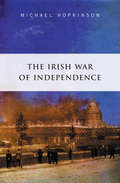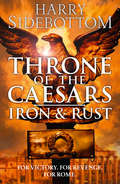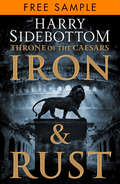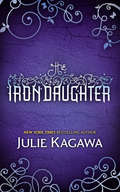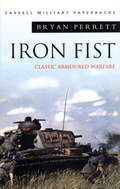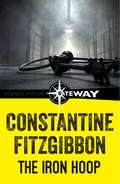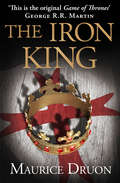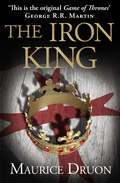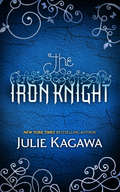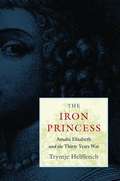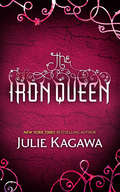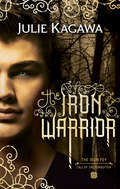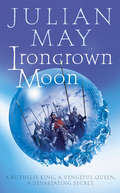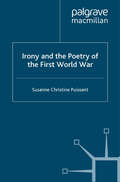- Table View
- List View
Irish Volunteer Soldier 1913–23 (Warrior #80)
by Bill Younghusband Gerry White Brendan O'SheaThe political situation in Ireland at the beginning of the 20th century was characterised by crisis and change. Armed rebellion against the British Crown, the prosecution of the Anglo-Irish War, the emergence of the Irish Free State, and the eruption of the Civil War over the treaty with Great Britain ensured that the birth of the modern Irish nation was bloody and difficult. This book details the life of an average Volunteer, and includes the experiences of internment, the lack of established medical facilities for wounded, life on the run, discipline, and typical duties.
The Irish War of Independence: The Definitive Account of the Anglo Irish War of 1919 - 1921
by Micahel HopkinsonWithin months of first publication, Michael Hopkinson's study of the Irish War of Independence established itself as by far most comprehensive and evocative account of the role played by the conflict in shaping modern Ireland. It has been welcomed both by scholars and the general public alike, and gone further than perhaps any other recent publication in recasting our understanding of Ireland's decisive confrontation with the military might of the British Empire.
Iron and Blood: A Military History of the German-speaking Peoples Since 1500
by Peter H. Wilson*WINNER OF THE DUKE OF WELLINGTON MEDAL FOR MILITARY HISTORY**A DAILY TELEGRAPH BOOK OF THE YEAR 2022*'No one interested in the history of Europe can afford not to read this stupendous book' Simon Heffer, Daily TelegraphIron and Blood is a startlingly ambitious and absorbing book, encompassing five centuries of political, military, technological and economic change to tell the story of the German-speaking lands, from the Rhine to the Balkan frontier, from Switzerland to the North Sea. Wilson's narrative considers everything from weapons development to recruitment to battlefield strategy.Germans' military impact on the rest of Europe has been immense. If there is one constant it has been the sense of being beset by seemingly more powerful enemies - France or Russia or Turkey - and the need to strike a rapid knockout blow to ensure a favourable result. Almost inevitably, this has in practice meant protracted, relentless and often unwinnable wars, and - in 1939-1945 - moral catastrophe.The author of definitive books on the Holy Roman Empire and the Thirty Years War, Peter Wilson has with Iron and Blood written his masterpiece.'Hugely impressive' Richard J. Evans, Times Literary Supplement
Iron and Rust: Throne Of The Caesars: Book 1 (Throne of the Caesars #1)
by Harry SidebottomFrom the bestselling author of WARRIOR OF ROME comes the first book in a new series set in third century Rome, a dramatic era of murder, coup, counter-rebellions and civil war.
Iron and Rust: Throne Of The Caesars: Book 1 (Throne of the Caesars #1)
by Harry SidebottomFrom the bestselling author of WARRIOR OF ROME comes the first book in a new series set in third century Rome, a dramatic era of murder, coup, counter-rebellions and civil war.
The Iron Daughter: The Iron King; The Iron Daughter (The Iron Fey #2)
by Julie KagawaStep back into the Faery realm… Half Summer faery princess, half human, Meghan has never fitted in anywhere.
Iron Fist: Classic Armoured Warfare Case Studies (Cassell Military Classics Ser.)
by Bryan PerrettThe greatest tank battles of history from the Great War to the Gulf, examined by one of Britain's bestselling military writers.The story of the evolution of armoured warfare in the 20th century, which has seen tanks and other armoured vehicles develop from lumbering, primitive and vulnerable Goliaths to the immensely potent and manoeuvrable agents of lightning battlefield success. This is a collection of the greatest moments of armoured history from the conception of the tank as a means to break the stalemate of the Western Front to Blitzkreig, the great tank battles of the Second World War and the 'mother of all battles' in the Gulf in 1991.
Iron Fist From The Sea: Top Secret Seaborne Recce Operations (1978-1988)
by Arne Soderlund Douw SteynFrom Cabinda in Angola to Dar es Salaam in Tanzania 4 Reconnaissance Regiment conducted numerous clandestine seaborne raids during the Border War. They attacked strategic targets such as oil facilities, transport infrastructure and even Russian ships. All the while 4 Recce’s existence and capability was largely kept secret, even within the South African Defence Force.With unparalleled access to previously top secret documents, 50 operations undertaken by 4 Recce, other Special Forces units and the South African Navy are described. The daunting Operation Kerslig (1981), in which an operator died in a raid on a Luanda oil refinery and others were injured, is retold in spine-tingling detail. The book reveals the versatility and effectiveness of this elite unit and also tells of both the successes and failures of its actions. Sometimes missions go wrong, as in Operation Argon (1985) when Captain Wynand Du Toit was captured.This fascinating work will enthrall anyone with an interest in Special Forces operations. Iron Fist from the Sea takes you right to the raging surf, to the adrenalin and fear that is seaborne raiding.
The Iron Hoop
by Constantine FitzgibbonOriginally published in 1950, The Iron Hoop is a novel of the victors and the vanquished. Set in New York in a post-war occupation era, the Iron Hoop is a ruined part of the city occupied by refugees, deserters, criminals and victims.
The Iron King (The Accursed Kings #1)
by Maurice Druon‘This is the original game of thrones’ George R.R. Martin From the publishers that brought you A Game of Thrones comes the series that inspired George R.R. Martin’s epic work.
The Iron King (The Accursed Kings #1)
by Maurice Druon‘This is the original game of thrones’ George R.R. Martin From the publishers that brought you A Game of Thrones comes the series that inspired George R.R. Martin’s epic work.
The Iron Knight: The Iron King, The Iron Daughter, The Iron Queen, The Iron Knight (The Iron Fey #4)
by Julie KagawaMy name – my True Name – is Ashallayn’darkmyr Tallyn. I am the last remaining son of Mab, Queen of the Unseelie Court. And I am dead to her. My fall began, as many stories do, with a girl…
The Iron Lady: Margaret Thatcher: From Grocer’s Daughter to Iron Lady
by John CampbellIn this abridged edition of John Campbell's two acclaimed volumes on Margaret Thatcher, we trace the life of Britain's only female Prime Minister, from her upbringing in Grantham to her unexpected challenge for leadership of the Conservative party to her eleven tumultuous years in Downing Street and her eventual removal from power. This is an extraordinary account of an extraordinary individual who changed the face of Britain; John Campbell portrays an ambitious and determined woman who started cautiously, grew in confidence after the Falklands War but became increasingly remote and domineering until she finally lost the trust of her colleagues.
Iron Men and Tin Fish: The Race to Build a Better Torpedo during World War II (War, Technology, and History)
by Anthony NewpowerFrom the American entry into World War II until September 1943, U.S. submarines experienced an abnormally high number of torpedo failures. These failures resulted from three defects present in the primary torpedo of the day, the Mark XIV. These defects were a tendency to run deeper than the set depth, the frequent premature detonation of the Mark 6 magnetic influence exploder, and the failure of the contact exploder when hitting a target at the textbook ninety-degree angle. Ironically, despite using a completely independent design, the Germans experienced the same three defects. The Germans, however, fixed their defects in six months, while it took the Americans twenty-two months. Much of the delay on the American side resulted from the denial of senior leaders in the operational forces and in the Navy's Bureau of Ordnance (BuOrd) that the torpedo itself was defective. Instead, they blamed crews for poor marksmanship or lack of training. In the end, however, the submarine force itself overcame the bureaucratic inertia and correctly identified and fixed the three problems on their own, proving once again the industry of the average American soldier or sailor.From the American entry into World War II until September 1943, U.S. submarines experienced an abnormally high number of torpedo failures. These failures resulted from three defects present in the primary torpedo of the day, the Mark XIV. These defects were a tendency to run deeper than the set depth, the frequent premature detonation of the magnetic influence exploder, and the failure of the contact exploder when hitting a target at the textbook 90-degree angle. Ironically, despite using a completely independent design, the Germans experienced the same three defects. The Germans, however, fixed their defects in six months, while it took the Americans 22 months. Much of the delay on the American side resulted from the denial of senior leaders in the operational forces and in the Navy's Bureau of Ordnance (BuOrd) that the torpedo itself was defective. Instead, they blamed crews for poor marksmanship or lack of training. In the end, however, the submarine force itself overcame the bureaucratic inertia and correctly identified and fixed the three problems on their own, proving once again the industry of the average American soldier or sailor.Contrary to the interpretations of most submarine historians, this book concludes that BuOrd did not sit idly by while torpedoes failed on patrol after patrol. BuOrd acknowledged problems from early in the war, but their processes and their tunnel vision prevented them from realizing that the weapon sent to the fleet was grossly defective. One of World War II's forgotten heroes, Admiral Lockwood drove the process for finding and fixing the three major defects. This is first book that deals exclusively with the torpedo problem, building its case out of original research from the archives of the Bureau of Ordnance, the Chief of Naval Operations, Vice Admiral Lockwood's personal correspondence, and records from the British Admiralty at the National Archives of the United Kingdom. These sources are complemented by correspondence and interviews with men who actually participated in the events.
The Iron Princess: Amalia Elisabeth And The Thirty Years War
by Tryntje HelfferichIn the bloodiest conflict Europe had ever experienced, Amalia Elisabeth fought to save her tiny German state, her Calvinist church, and her children’s inheritance. Tryntje Helfferich reveals how this embattled ruler used diplomacy to play the European powers against one another, while raising one of the continent’s most effective fighting forces.
The Iron Princess: Amalia Elisabeth And The Thirty Years War
by Tryntje HelfferichIn the bloodiest conflict Europe had ever experienced, Amalia Elisabeth fought to save her tiny German state, her Calvinist church, and her children’s inheritance. Tryntje Helfferich reveals how this embattled ruler used diplomacy to play the European powers against one another, while raising one of the continent’s most effective fighting forces.
The Iron Queen: The Iron King, The Iron Daughter, The Iron Queen, The Iron Knight (The Iron Fey #3)
by Julie KagawaFrom New York Times bestselling author, Julie Kagawa… In less than twenty-four hours I’ll be seventeen. Although, technically, I won’t actually be turning seventeen. I’ve been in the Nevernever too long. When you’re in Faery, you don’t age.
The Iron Sea: How the Allies Hunted and Destroyed Hitler's Warships
by Simon ReadFrom the acclaimed military history author, this action-packed World War II history describes the Allies' brutal naval engagements and daring harbor raids to destroy the backbone of Hitler's surface fleet.The sea had become a mass grave by 1941 as Hitler's four capital warships -- Scharnhorst, Gneisenau, Tirpitz, and Bismarck, the largest warship on the ocean -- roamed the wind-swept waves, threatening the Allied war effort and sending thousands of men to the icy depths of the North Atlantic. Bristling with guns and steeled in heavy armor, these reapers of the sea could outrun and outgun any battleship in the Allied arsenal. The deadly menace kept Winston Churchill awake at night; he deemed them "targets of supreme consequence."The campaign against Hitler's surface fleet would continue into the dying days of World War II and involve everything from massive warships engaged in bloody, fire-drenched battle to daring commando raids in German occupied harbors. This is the fast-paced story of the Allied bomber crews, brave sailors, and bold commandoes who "sunk the Bismarck" and won a hard-fought victory over Hitler's iron sea.Using official war diaries, combat reports, eyewitness accounts and personal letters, Simon Read brings the action and adventure to vivid life. The result is an enthralling and gripping story of the Allied heroes who fought on a watery battlefield.
The Iron Warrior: The Lost Prince The Iron Traitor The Iron Warrior Winter's Passage Summer's Crossing Iron's Prophecy (The Iron Fey #7)
by Julie KagawaThe Iron Warrior is Kagawa’s stellar conclusion to the internationally bestselling Iron Fey series. Are you ready…? The Iron Prince betrayed us all. He killed me. Then, I woke up.
The Iron Way (The Sarmatian Trilogy)
by Tim LeachA gripping historical adventure set in the second century AD and based on legends of King Arthur, The Iron Way is the second in Tim Leach's breathtaking Sarmatian Trilogy. AD 175, Vindolanda, Britannia.After their cavalry was broken by the legions on the frozen waters of the Danube, Sarmatian warrior Kai bought his peoples' lives with a pledge to serve Rome. Bound to the will of the Emperor, the Sarmatians are ready to fight and eager to die – death in battle is the only escape from the dishonour of their defeat.Exiled from their home lands, they are ordered to take the Iron Way to the far north and the very edge of the Empire. Here, a great wall of stone cuts across the land as straight as the stroke of a sword. On one side, Rome's dominion; on the other, mist and rumours – stories of men closer to giants, of warriors who fight without fear or restraint.For a people who knew no borders, who were promised war, garrison duty is cruel punishment. But as insurrection stirs on both sides of the wall, Kai will discover that every barrier has its weaknesses – and he will have his chance to fight, perhaps to die.Reviewers on the Sarmatian Trilogy and Tim Leach: 'Roman military adventure at its best. Ranks with the best historical fiction available today.' Simon Turney 'A great story from a fascinating period... masterfully written with beautiful language.' Historical Novel Society 'The characters feel rounded and real, and the Sarmatians' attempts to keep their world alive and evade the tyrannous reach of Rome are heartbreaking.' The Times 'Tim Leach writes beautifully.' For Winter Nights 'Recommended.' Historical Novel Society 'Magnificent' Historia 'A poetic, absorbing narrative.' Sunday Times
An Iron Wind: Europe Under Hitler
by Peter FritzscheA vivid account of German-occupied Europe during World War II that reveals civilians' struggle to understand the terrifying chaos of warIn An Iron Wind, prize-winning historian Peter Fritzsche draws diaries, letters, and other first-person accounts to show how civilians in occupied Europe tried to make sense of World War II. As the Third Reich targeted Europe's Jews for deportation and death, confusion and mistrust reigned. What were Hitler's aims? Did Germany's rapid early victories mark the start of an enduring new era? Was collaboration or resistance the wisest response to occupation? How far should solidarity and empathy extend? And where was God? People desperately tried to understand the horrors around them, but the stories they told themselves often justified a selfish indifference to their neighbors' fates. Piecing together the broken words of the war's witnesses and victims, Fritzsche offers a haunting picture of the most violent conflict in modern history.
Ironcrown Moon: Part Two Of The Boreal Moon Tale (The\boreal Moon Tale Ser. #Vol. 2)
by Julian MayThe continuation of a powerful new fantasy adventure filled with dark magic and deadly intrigue, from the worldwide bestselling author of the SAGA OF THE PLIOCENE EXILE.
Ironside: The Authorised Biography of Field Marshal Lord Ironside
by Lord Edmund IronsideField Marshal Lord Ironside was a born commander and, besides being a gifted linguist, was mobilised as a subaltern for the Boer War to act as a secret agent and to streamline the peace process. After serving on the Western Front for most of the First World War he became C-in-C of the Expeditionary Force in North Russia and, being knighted and promoted to major general by the age of 39, went on to modernise staff training at Camberley and to champion mechanised and aerial warfare. His generalship was tested out in the Raj and, in 1939, on the day war was declared, he reached the top of the British Army leadership as CIGS. In that capacity he played a key role in developing strategy during the first months of the war, before helping to organise the defence of Calais to free up the British Expeditionary Force escape route to Dunkirk. After a final stint as C-in-C Home Forces, preparing to resist German invasion, he was given his baton and raised to the peerage. This first full authorised biography, written by his son, Edmund Ironside, and based upon the field marshal’s meticulously kept diaries covering more than fifty years, is the definitive account of the incredibly varied and long career of one of the most prolific military leaders of the twentieth century.
Irony and the Poetry of the First World War
by S. PuissantHow does irony affect the evaluation and perception of the First World War both then and now? Irony and the Poetry of the First World War traces one of the major features of war poetry from the author's application as a means of disguise, criticism or psychological therapy to its perception and interpretation by the reader.
Irradiated Cities
by Mariko Nagai NagaiThe before, the after, and the event that divides. In Irradiated Cities, Mariko Nagai seeks the dividing events of nuclear catastrophe in Japan, exploring the aftermath of the bombings at Hiroshima and Nagasaki and the nuclear meltdown at Fukushima. Nagai’s lyric textual fragments and stark black and white photographs act as a guide through these spaces of loss, silence, echo, devastation, and memory. And haunting each shard and each page an enduring irradiation, the deadly residue of catastrophe that leaks into our DNA. Winner of the 2015 NOS Book Contest, as selected by guest judge lê thi diem thúy.

